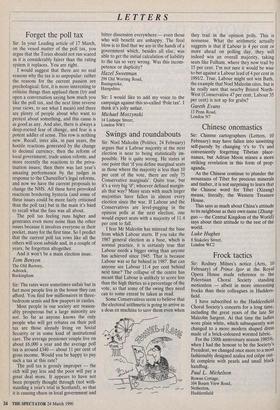Swings and roundabouts
Sir: Noel Malcolm (Politics, 24 February) argues that a Labour majority at the next election is near to being statistically im- possible. He is quite wrong. He states at one point that 'if you define marginal seats as those where the majority is less than 10 per cent of the vote, there are only 75 Conservative marginals'. Quite true, but it's a very big 'if' ; whoever defined margin- als that way? Many seats with much larger majorities have fallen in almost every election since the war. If Labour and the Conservatives are level-pegging in the opinion polls at the next election, one would expect seats with a majority of 11.4 per cent to fall.
I fear Mr Malcolm has misread the base from which Labour starts. If you take the 1987 general election as a base, which is normal practice, it is certainly true that Labour needs a bigger swing than anyone has achieved since 1945. That is because Labour was so far behind in 1987. But can anyone see Labour 11.4 per cent behind next time? The collapse of the centre has meant that Labour is unlikely to score less than the high thirties as a percentage of the vote, so that some of the swing they need can to some extent be taken as read.
Some Conservatives seem to believe that the electoral arithmetic is going to arrive as a deus ex machina to save them even when they trail in the opinion polls. This is nonsense. What the arithmetic actually suggests is that if Labour is 4 per cent or more ahead on polling day, they will indeed win an overall majority, taking seats like Fulham, where they now trail by 15 per cent. I'm not sure it would be wise to bet against a Labour lead of 4 per cent in 1991/2. True, Labour might not win Bath, the example that Noel Malcolm cites, but is he really sure that nearby Bristol North- West (Conservative 47 per cent, Labour 35 per cent) is not up for grabs?
Gareth Evans
13 Penn Road, London N7


















































 Previous page
Previous page